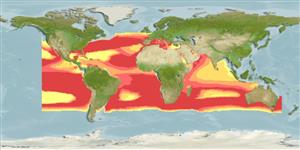Common names from other countries
>
Lampriformes (Velifers, tube-eyes and ribbonfishes) >
Lophotidae (Crestfishes)
Etymology: Lophotus: Greek, lophos = crest (Ref. 45335).
Issue
Species spelling Eschmeyer, pers. comm.
Environment: milieu / climate zone / depth range / distribution range
Ecologia
marino batipelagico; oceanodromo (Ref. 51243); distribuzione batimetrica 0 - 92 m (Ref. 36608). Deep-water; 51°N - 45°S, 130°W - 158°E
Nearly worldwide in warmer seas. Western Atlantic: Florida in USA to Brazil (Ref. 7251). Eastern Atlantic: western Mediterranean, off Portugal, Madeira and off Canary Islands; also South Africa (Ref. 4165). Western Indian Ocean: recently recorded from Reunion (Ref. 53568). Eastern Pacific: southern California, USA (Ref. 6740). Also reported from Australia (Ref. 9563).
Size / Peso / Age
Maturity: Lm ? range ? - ? cm
Max length : 200 cm TL maschio/sesso non determinato; (Ref. 4165); common length : 100.0 cm TL maschio/sesso non determinato; (Ref. 3397)
Spine dorsali (totale) : 0; Raggi dorsali molli (totale) : 206 - 263; Spine anali: 0; Raggi anali molli: 5 - 20; Vertebre: 124 - 153. Head and body silvery in color and possibly with silvery spots; fins red (Ref. 4165).
A rare (Ref. 4165), oceanic, mesopelagic species. Occasionally stranded in shallow water (Ref. 9563). Capable of discharging a black ink from an ink-sac in the cloaca when alarmed. Adults feed on fishes (anchovies) and squids (Ref. 6740). Oviparous, with planktonic eggs and larvae (Ref. 36608). Found in stomachs of tunas (Ref. 2850).
Life cycle and mating behavior
Maturities | Riproduzione | Spawnings | Egg(s) | Fecundities | Larve
Palmer, G., 1986. Lophotidae. p. 734-735. In P.J.P. Whitehead, M.-L. Bauchot, J.-C. Hureau, J. Nielsen and E. Tortonese (eds.) Fishes of the north-eastern Atlantic and the Mediterranean. UNESCO, Paris. Vol. 2. (Ref. 6740)
IUCN Red List Status (Ref. 130435)
CITES (Ref. 128078)
Not Evaluated
Threat to humans
Harmless
Human uses
Pesca: di nessun interesse
Strumenti
Special reports
Download XML
Fonti Internet
Estimates based on models
Preferred temperature (Ref.
115969): 15.2 - 26.9, mean 22.1 (based on 1116 cells).
Phylogenetic diversity index (Ref.
82804): PD
50 = 0.6875 [Uniqueness, from 0.5 = low to 2.0 = high].
Bayesian length-weight: a=0.00389 (0.00180 - 0.00842), b=3.12 (2.94 - 3.30), in cm Total Length, based on all LWR estimates for this body shape (Ref.
93245).
Trophic level (Ref.
69278): 4.5 ±0.67 se; based on food items.
Fishing Vulnerability (Ref.
59153): Very high vulnerability (90 of 100).
